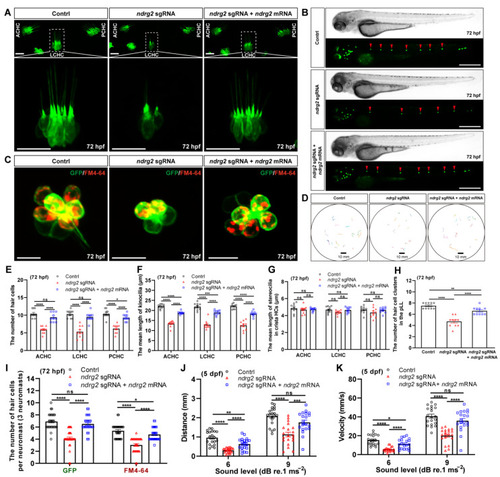
Knockout of the ndrg2 gene disrupted hair cell (HC) morphogenesis and caused defective sensory ability to sound vibration stimuli in zebrafish (Danio rerio). (A) Representative fluorescence graphs of the typical three clusters of crista HCs in normal, ndrg2 mutants, and ndrg2 mRNA rescued larvae at 72 hpf, respectively. The details of lateral crista hair cell (LCHC) (marked with white dashed box) were magnified in corresponding larvae. Scale bars: 20 µm. (B) Phase-contrast and fluorescence images of HC clusters (marked with red arrowheads) in posterior lateral line (pLL) at 72 hpf from the control, ndrg2 mutants, and ndrg2 mRNA rescued groups, respectively. Scale bars: 500 µm. (C) Overlapped fluorescence images of a representative neuromast in pLL from normal, ndrg2 mutants, and ndrg2 mRNA rescued larvae at 72 hpf, respectively. The green and red signals represented HCs and functional HCs, respectively. Scale bars: 10 µm. (D) Swimming trajectories extracted from once startle response behavior to sound stimuli of 9 dB re.1 ms−2 with 180 Hz tone bursts in the normal, ndrg2 mutants, and ndrg2 mRNA rescued larvae at 5 dpf, respectively. (E–I) Statistical analysis of the morphological phenotypes of HCs emerging in ampulla crista of otic vesicle and neuromasts in pLL at 72 hpf in the control, ndrg2 mutants, and ndrg2 mRNA rescued groups, respectively ((E–H), n = 10; (I), n = 30). (J,K) Statistical analysis of the mean distance and peak velocity of locomotion under two levels stimuli in the control, ndrg2 mutants, and ndrg2 mRNA rescued groups, respectively (n = 20). Symbols of *, **, ***, and **** above bars represent p < 0.05, p < 0.01, p < 0.001, and p < 0.0001, respectively. ns, no significance.
|

